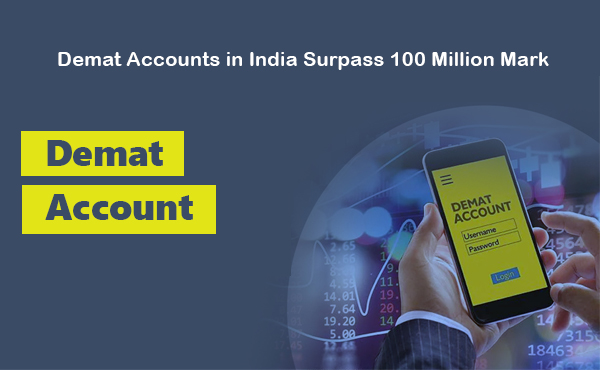The Indian financial landscape witnessed a momentous occasion as the number of Demat accounts in the country crossed a staggering 100 million mark. This remarkable achievement reflects the increasing interest of Indian investors in the equity market and their transition towards digital investment platforms. Let’s delve into the significance of this milestone and explore the factors contributing to this substantial growth.

What is a Demat Account?
A Demat account, short for “Dematerialized account,” is a specialized electronic account used by investors to hold and manage their financial securities in digital form. In contrast to the traditional physical certificates representing ownership of stocks, bonds, mutual funds, and other securities, a Demat account holds these assets in a paperless and electronic format.
The advent of Demat accounts revolutionized the process of buying, selling, and holding securities, making it more convenient, secure, and efficient for investors. When an individual purchases shares or other financial instruments, the corresponding ownership rights are reflected in their Demat account.
Here’s how a Demat account works:
Account Opening: Investors can open a Demat account through authorized depository participants, such as banks or brokerage firms, by submitting necessary documents and completing the registration process.
Dematerialization: After opening the account, physical share certificates can be converted into electronic form through a process called dematerialization. This involves submitting the physical certificates to the depository participant, who will then credit the equivalent digital securities to the Demat account.
Holding Securities: Once the Demat account is active, investors can buy and sell securities through various platforms like stock exchanges or mutual fund distributors. The purchased securities are automatically credited to the Demat account, while the sold securities are debited from it.
Statement and Transaction Tracking: Investors receive regular statements that detail the holdings and transactions in their Demat account. These statements provide a comprehensive overview of the investor’s portfolio.
Benefits of Demat Account:
a. Convenience: Demat accounts eliminate the need to handle physical certificates, streamlining the process of buying and selling securities from anywhere with an internet connection.
b. Safety: The electronic format reduces the risk of loss, theft, or forgery, ensuring the safety of the investor’s assets.
c. Easy Transfer: Transferring securities from one Demat account to another is hassle-free and can be completed electronically.
d. Quick Settlement: Transactions settle faster in the electronic format, reducing the settlement time compared to physical certificates.
e. Reduced Paperwork: Investors no longer need to maintain voluminous paperwork related to their securities, making record-keeping easier.
Demat accounts have become an integral part of the modern financial system, empowering investors with a secure and efficient platform to participate in the capital markets and manage their investment portfolios with ease.
Reasons behind the Surge in the Number of Demat Accounts
Demat Accounts: A Paradigm Shift in Investing
Dematerialized (Demat) accounts revolutionized the way Indians invest in securities. Gone are the days of physical share certificates, replaced by electronic formats. This transformation not only facilitates seamless trading and holding of stocks but also offers security, convenience, and ease of access to investment portfolios.
Surge in Retail Investors
The upsurge in the number of retail investors in India played a pivotal role in this accomplishment. Over the last few years, the Indian stock market witnessed a surge in retail participation, driven by increased financial literacy, improved digital infrastructure, and the allure of potential returns.
Technological Advancements: Catalyst for Growth
The advent of robust digital platforms and brokerage apps further fueled the growth of Demat accounts. These user-friendly interfaces, combined with seamless account opening processes, attracted a significant portion of the population to explore the world of investments.
Rise of Systematic Investment Plans (SIPs)
Systematic Investment Plans (SIPs) gained immense popularity in recent years as a disciplined approach to investing in mutual funds. The ease of setting up SIPs through Demat accounts attracted both new and seasoned investors, contributing to the soaring number of accounts.
Government Initiatives and Regulations
The Indian government’s initiatives to promote financial inclusion and ease of investing played a crucial role in reaching this milestone. Moreover, investor-friendly regulations and continuous efforts to safeguard investor interests boosted confidence in the financial markets.
Awareness and Education
Financial literacy campaigns and educational initiatives by market regulators, financial institutions, and other stakeholders have played an instrumental role in fostering investor awareness. As more people understood the benefits of investing through Demat accounts, the demand for these accounts surged significantly.
How to Open a Demat Account in India?
Opening a Demat account in India is a straightforward process that enables you to hold and manage your financial securities in electronic format. To get started, follow these steps:
Choose a Depository Participant (DP):
Select a reputable Depository Participant (DP) through which you want to open your Demat account. Authorized entities known as Depository Participants (DPs) act as intermediaries between investors and depositories such as the National Securities Depository Limited (NSDL) and Central Depository Services Limited (CDSL).
Complete the Account Opening Form:
Visit the DP’s website or their physical office and request an account opening form. Fill out the required details, including personal information, contact details, and financial background.
Submit Necessary Documents:
Along with the completed account opening form, submit the following documents:
- Proof of Identity (POI): Aadhaar card, passport, voter ID, or any other government-issued photo ID.
- Proof of Address (POA): Aadhaar card, passport, driving license, utility bills, or bank statement (not more than 3 months old).
- Passport-sized photographs.
- PAN card (Permanent Account Number).
Verification Process:
The DP will verify your documents and conduct the Know Your Customer (KYC) process as per regulatory requirements. This may involve in-person verification or a video call to confirm your identity.
Sign Agreement and Disclosures:
Read and sign the agreement and disclosures provided by the DP, which outline the terms and conditions of your Demat account.
Account Activation:
Once your application is processed and approved, your Demat account will be activated. The DP will provide you with a unique Demat account number (similar to a bank account number) that you’ll use for all your investment transactions.
Link Your Bank Account:
Link your existing bank account with the newly opened Demat account. This is crucial for seamless fund transfers during the buying and selling of securities.
Start Investing:
With your Demat account now active, you can begin investing in various financial instruments such as stocks, bonds, mutual funds, and exchange-traded funds (ETFs). You can do so through online trading platforms, brokerage firms, or mutual fund distributors.
Remember to keep your account details and login credentials secure to ensure the safety of your investments.
It’s important to note that some DPs may charge account opening fees and maintenance charges. Make sure to understand the fee structure and other terms before finalizing the account opening process.
By following these steps, you’ll be able to open a Demat account in India and embark on your journey as an investor in the financial markets.
Conclusion
The crossing of the 100 million Demat accounts mark in India stands as a testament to the growing financial awareness and digital transformation of the country’s investment landscape. With increased retail participation, technological advancements, and favorable government policies, India’s financial markets are poised for further growth and development.






